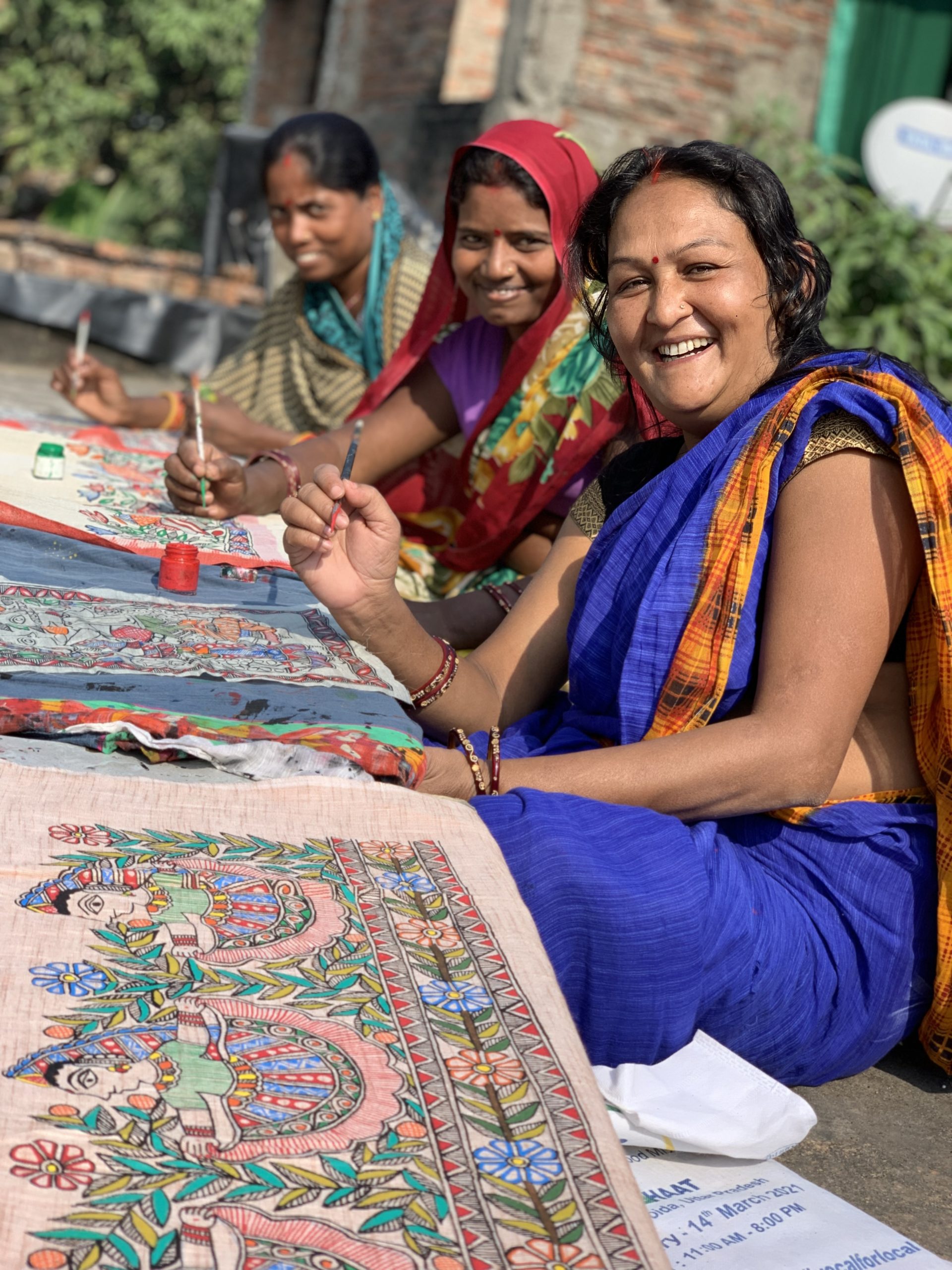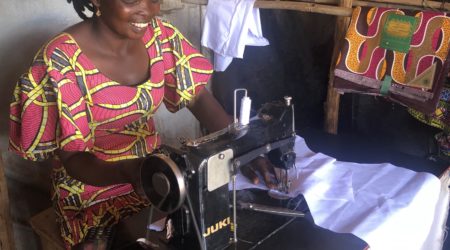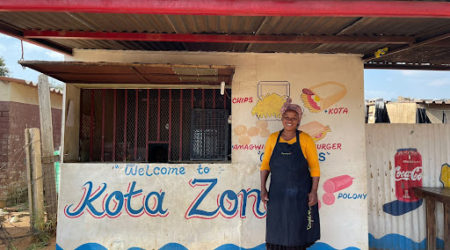Unlocking the potential of digital commerce for women artisans in India

Sunrekha, a 35-year-old woman from Ranti in the Madhubani district of Bihar, joined a women’s collective in her village seven years ago. Growing up, she had learnt the age-old madhubani art from her aunt, but not enough to ever propel her into mainstream manufacturing. Sunrekha is valued in her neighborhood as someone who is dependable, quick to learn, and always willing to help. As a high school graduate, she usually spends her day taking care of her two kids, helping them with their school homework. She owns a smartphone and is adept at WhatsApp and is beginning to foray into other social media apps such as Facebook and YouTube. In spite of her digital savviness, Sunrekha has limited understanding of online marketplaces and the potential of handcrafted goods in the market. In 2015, she was introduced to the state initiative JEEViKA by her neighborhood friend, and soon she joined the collective Shilp Sangh and quickly understood the market potential for the art she had learnt while growing up.
In 2018, Shilp Sangh along with 12 such collective enterprises in neighboring villages, also locally known as Producer Groups, formed a Producer Company named Shilpgram. It is through Shilpgram that Sunrekha found appropriate marketing channels, the required technical support and improved branding that helped her sell her products at a reasonable price and to a bigger audience. Not only that, through the collective, Sunrekha was able to formalize her skills and learn about fashion-forward designs that Madhubani artists are creating in the country.
More than 50 percent of artisans in India are women and from marginalized groups, most of whom are working in an informal and home-based setting. The unorganized nature and fragmented institutional framework of the Indian handicrafts sector, coupled with low capital and limited digital access, cause these informal businesses to struggle. Based mostly in rural areas, artisans have limited market intelligence, inadequate channels to sell their products in the absence of any real access to city-based customers and high-end markets. They face prohibitive transportation costs and culturally-imposed normative barriers that limit mobility and access to markets. Together with low levels of education and limited digital literacy, the overall reach, popularity, and profitability of the informal businesses are reduced.
Shilpgram groups small-scale producers to deliver economies of scale and help producers move into higher-value sectors and access higher prices for their outputs. However, Shilpgram, like many rural producers and collective enterprises, has felt the negative impacts of the COVID-19 pandemic. As their sales come mostly from offline channels such as state-organized fairs and markets, which were not operating due to restrictions on in-person interaction, Shilpgram’s sales plummeted. They, like most- self help groups in India, have survived because of government orders for masks which, despite having limited profit margins, got fulfilled quickly due to the complete absence of any other sales channels. Many producer groups have been left with huge unsold inventories worth 1 to 1.5 lakhs (USD$1300 to USD$2000) which are starting to deteriorate as their storage capacity is limited.

In frame: Shilpgram CEO Richa Shrivastava with members of Madhuban Mithila producer group
In response to these issues, BFA Global, with the support of Gates Foundation India, started working with Shilpgram in August 2021 to enable their transition to a digital platform for sales of traditional Indian handicrafts. Specifically, our pilot project is working to connect Shilgram’s women artisans with high-paying customers using digital platforms and tools. This includes a revamped brand identity and visual design to better communicate Shilpgram’s core values and propositions. We are working with the team on a platform to sell directly to customers online, and using digital media tools like WhatsApp and Instagram to establish critical customer relationships. As well, we’re finding meaningful demand opportunities via influencer marketing, B2B resellers, and brand collaborations. At the same time, we are optimizing the supply value chain for all the stakeholders involved in the process – getting orders to satisfied customers more easily and efficiently – while streamlining the backend operations.

In frame: BFA Global team meeting the artisans in various parts of Bihar
The opportunities presented by this project for these women artisans are immense. India is one of the fastest-growing digital commerce markets in the world, particularly e-commerce and social commerce. Thanks to this growth, medium, small, and micro enterprises (MSMEs) in the country are experiencing a boom with projections estimating 400 percent growth by 2025.
In spite of its many challenges, COVID-19 has proved to be an accelerant for digital commerce across developing economies. In 2020 alone, India’s social commerce gross merchandise value (GMV) stood at approximately US$2 billion. There is also increasing activity coming in from tier-II cities in India, which is representative of the market potential that digital commerce is unlocking beyond high-paced urban centres. Data reveals that 11 percent of customers tried online purchases for the first time, while 30 percent of them reported buying more online than before the pandemic. Similarly, more than 60 percent of respondents in a survey of over 500 Indian MSMEs reported that transitioning to selling via digital platforms allowed them to survive during the lockdown restrictions.
While the market potential is clear, there remains a gap when it comes to the share of women-owned businesses, which make up only about 20 percent of all MSMEs in the country, with the highest concentration in micro-enterprises. India ranks third-highest in the entrepreneurship gender gap across the world, even as women’s businesses’ profit margins stand at 31 percent compared to 19 percent of men’s. The COVID-19 pandemic has also severely and disproportionately affected women-owned businesses in India, with approximately 12 percent reporting permanent closures.
According to a survey conducted by the International Finance Corporation (IFC), lack of access to capital remains the single biggest barrier for growth for women-owned MSMEs. Other barriers include lack of know-how when it comes to financial planning, or using digital tools to improve their marketing and sales channels. Coupled with lower mobile phone penetration and restrictive social and cultural norms, these factors have slowed down growth for women’s businesses, leaving a huge gap and a tremendous amount of unrealized potential on the table. This trend is not isolated to India, with global estimates suggesting nearly 63 to 69 percent of women-owned MSMEs are unserved or underserved by financial institutions. This amounts to a global credit gap of approximately US$260 to $US320 billion.

In frame: Narmada Devi, Director of Shilp Sangh group, who has been practising the Madhubani art form for over 4 decades. She now takes pride in training and mentoring young artisans in her group to make them financially independent.
However, we see a new class of cultural economy emerging. The “New Formal” as this NextBillion article notes, “is an emergent hybrid approach that combines the benefits and best practices of the informal space (e.g., cultural networks, labour relationships, and behaviours rooted in social, familial, ethnic and caste dynamics) and the formal space (e.g., social protections, data, and economic and social mobility).” Part of this class are collective enterprises that have been a powerful model for helping women overcome these barriers to growth.
Along with providing social support and confidence, group membership helps women access a range of services such as training, capital, and legal advice. Groups help increase access to markets, improve commercialization by creating linkages to high-value markets and reduce the overall transaction costs. The power of networking, solidarity and collective decision-making helps women in building stronger livelihoods and sustaining their families via increased incomes and greater market access.

In frame: Artisans of Maa Gayatri producer group enjoy some time together outside their workplace in Madhubani
With Shilpgram now venturing successfully into the world of digital commerce, Sunrekha is excited by the new opportunities it presents. She gets to see her handcrafted creations not only contributing to her income but also being appreciated by hundreds of handicraft lovers on social media, opening new doors of social and financial empowerment that she didn’t previously know existed. While Shilpgram keeps the age-old art alive, Sunrekha is motivated to pass down the art form to the next generation knowing it’s a sustainable avenue for income generation.
BFA Global is encouraged by the early results of this pilot with a solid average quarterly growth of 300 percent and the ability of digital commerce to improve the lives and livelihoods of women like Sunreka. As we continue to help Shilpgram access niche customers and high-paying markets, we are also working with the team on their backend, supply and logistics. Our ultimate goal is to strengthen and streamline the entire value chain from order placement, to inventory management, to order delivery, and set Shilpgram and its artisans up for sustained success and growth.

![[Press Release] 7 African Startups to Receive $385k to Develop Solutions for the Blue Economy](https://bfaglobal.com/wp-content/uploads/2023/02/Wave-1-startup-announcement--450x250.png)

